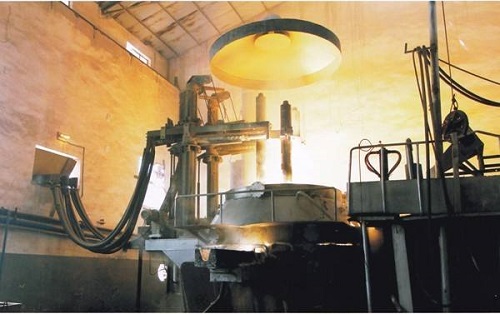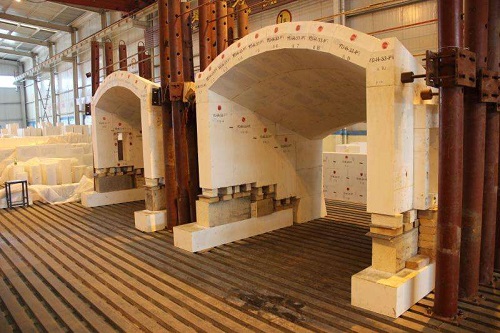[Zhongbo.com] Refractory is the material basis of glass kiln. It has a great impact on the overall efficiency of the kiln, and must be carefully selected. The refractory material is not only used in large quantities, but a 500t/d float glass melting furnace is about 5,000 tons of refractory material, and its cost accounts for the main proportion of the entire kiln cost and even the entire plant investment, so it must be reasonably selected. The so-called rationality, that is, both technical and economic aspects should be "appropriate." The selection principle should follow the following points: 1 to meet the necessary performance properties, such as high temperature properties, chemical stability, thermal stability, volume stability and mechanical strength. 2 does not pollute the glass liquid, does not affect the quality of the glass liquid. 3 as long as possible. 4 There is no contact reaction between the refractory materials of different materials that are built together at high temperature. 5 Use as little material and heat loss as possible. 6 The vulnerable parts are made of high-quality materials, and other parts are made of general materials, so that "reasonable matching, kiln age synchronization". Damage to refractory materials used in glass kiln When refractory materials are used in glass kiln, they will be seriously damaged due to high temperature, flame, powder, atmosphere, air flow and liquid flow, which greatly affects the service life of the kiln. From the kiln, the use of refractory materials in the kiln begins, and improper operation will also cause large, even severe damage to the refractory material, which requires special attention. The following describes several types of damage. Corrosion The kiln powder, glass liquid and flame gas will erode the refractory material at high temperatures. The soda ash, the mirabilite, the borate, the fluoride and the oxide in the batch react with the surface of the refractory material at a high temperature to form a eutectic or a loose substance, and continue to pass the void reaction of the refractory material itself or the interfacial reaction of the interface. The interior of the brick body is infiltrated and diffused, and the refractory material is gradually dissolved, peeled off, thinned, deteriorated, recrystallized, and the like. The corrosion mechanisms of the above various salts and compounds are different, and the Glauber's salt is much stronger than the soda ash. The erosion effect of the powder on the refractory material is mainly manifested in the erosion of the refractory by the alkaline vapor evaporated by the high temperature of the powder, such as the erosion of the surface of the silica brick, the internal "rat hole", etc., and the anti-geochemical in the lattice brick. Function and so on. Furthermore, the ultrafine powder in the powder accumulates in the lattice of the regenerator to form a tumor, which blocks the lattice hole. When it is serious, the lattice brick collapses and is damaged, and is forced to be repaired. The erosion effect is exacerbated by the increase in temperature, and the increase in the melting temperature by 50 to 60 ° C shortens the service life by about one year. The front face wall, the feeding port, the front part of the melting section, the pool wall, the small furnace, the upper lattice of the regenerator, and the like are all damaged by the powder. The corrosion effect of the glass liquid on the refractory material is much smaller than that of the powder, and the phase reaction between the glass liquid and the refractory interface layer is complicated. The glass liquid first dissolves the free SiO2 in the refractory. The dissolution rate of mullite is small, and it accumulates at the interface between the glass liquid and the refractory material. Although the small crystal mullite is dissolved, the large crystal mullite even increases in use. After the refractory material is eroded, the composition in contact with it adds SiO2 and Al2O3 components. The melt will diffuse into the rest of the glass. During the diffusion process, the composition of the melt changes, SiO2 and lye increase, and the aggregation of β-Al2O3 crystals occurs at the interface. Therefore, on the contact surface between the refractory and the glass, the first is Molai. The stone layer is followed by a layer of β-Al 2 O 3 followed by an unetched refractory material. After the refractory material is dissolved, the viscosity of the glass liquid is increased, which promotes the formation of a protective layer which is difficult to move on the surface of the refractory material, and the effect of continuing erosion is weakened. The erosive effect of molten glass on refractory materials depends on physical properties such as viscosity and surface tension. A glass with a low viscosity and a small surface tension is more likely to infiltrate the refractory material and is sucked into the interior from the pores of the surface, so that the entire refractory material is strongly eroded. High alkali glass has a low viscosity, and borosilicate glass has a small surface tension, so that its erosion is severe. Increasing the melting temperature reduces the viscosity and surface tension of the molten glass, which also accelerates the erosion. The glass liquid containing boric acid, phosphoric acid, fluorine, aluminum and antimony compound has a strong erosive effect on the refractory material, and the strong convection of the molten glass and the unstable liquid surface will wash away the protective layer and accelerate the erosion. For the refractory itself, the degree of corrosion is mainly related to its chemical composition, mineral composition and structural state. Generally, the structure of the refractory material is composed of one or more crystal phases, a glass phase and a gas phase. Pores, especially open pores, are channels through which the etchant penetrates into the interior of the refractory material and increase the erosion surface. Compared with the crystal phase, the glass phase is a weak link, and its chemical stability is poor. To improve the corrosion resistance of the refractory material, it is necessary to increase the stable crystalline phase at a high temperature, reduce the content of the glass phase, and have a large softening temperature and viscosity, and the pores. The rate is as low as possible. In addition, it is also required that the crystal phase is fine and uniformly distributed in the glass phase to form a uniform and dense structure. The surface roughness and crack of the refractory material will intensify the erosion. The brick wall and pool wall brick joint at the liquid level are in the place where the glass liquid is easily damaged. The horizontal seam is more severe than the vertical seam, so the masonry surface is required. Smooth, small cannon seams, and must be built in one piece. Combustion products of gas and heavy oil (containing corrosive gases such as SO2 and V2O5) and volatiles of individual batch components may also corrode refractory materials in flame spaces, furnaces, regenerators, and the like. Different furnace materials react with each other at high temperatures, resulting in damage. For example, 1600~1650 °C, clay bricks and silica bricks will react violently, high alumina bricks and silica bricks will have moderate reaction, and fused zirconium corundum bricks and silica bricks will react violently and be eutectic. The fused zirconium corundum brick reacts moderately with quartz bricks and white foam, but reacts with corundum bricks. Therefore, corundum brick can be used as a transition material. The lattice used in the regenerator is also destroyed by the action of redox atmosphere. The damage mechanism is mainly due to the different valence states of the valence ions in the oxidized and reduced states, and the coordination state is different, resulting in volume change, resulting in a decrease in product strength and cracking. Burnt out Under the action of high temperature for a long time, the refractory material will be melted (also called burned) or softened and damaged. Local overheating of a part of the kiln or the refractory strength of the refractory material is insufficient. The refractory material is melted. Sometimes, the refractoriness is acceptable, but the load softening temperature is low. When used for a long time, the refractory material will soften and deform, which affects the stability and service life of the entire masonry. The severity of burnout depends on the temperature and the nature of the refractory material. The small furnace blasting port, the small furnace legs, the tongue, the regenerator chamber, the melting part kiln and the chest wall are easily burnt parts. Crack The cracking mainly occurs in the kiln stage. When the kiln is baked, a certain temperature difference occurs inside the refractory brick, and corresponding mechanical stress is generated. If the rate of temperature rise is too fast and exceeds the ultimate strength allowed by the refractory, cracks may occur and even break into pieces. The fused, highly sintered dense refractory material is more susceptible to breakage. In addition to the temperature difference to generate stress, the expansion or contraction caused by the change in the crystal form of the refractory material also generates stress. When the temperature rises too fast, the crystal form changes rapidly, the volume changes too much, and the stress is excessively generated, causing the refractory material to crack. Therefore, in the kiln, it must be heated according to the pre-established kiln curve. After the kiln is kiln, the refractory material is exposed to high temperature for a long time, and the mechanical strength of the refractory material at the working temperature is much lower than that at room temperature. If the mechanical load acting on the refractory material is too large, the refractory material will be inelastically deformed (similar to the extremely viscous liquid flow) and cause damage. abrasion The glass liquid has the effect of dripping water and stone when flowing along the refractory material, and the refractory material is ground out of a groove, which is mechanical wear. The main wear site is at the glass level. In addition, it is also clearly visible at the flow of the circulating fluid (especially where the flow is disordered). Wear is exacerbated when liquid level fluctuations and liquid flow changes (such as those affected by temperature fluctuations).
Serving the industry with our best quality
products, we manufacture, supply Coral Fleece slipper. This product has perfect
fittings and made with excellent quality. It ensures durable finish and water
resistant. It does not give uncomfortable feel at first wear. These are offered
in various sizes, depending upon the need of the client. We have been applauded
for this superior quality product every time we have delivered.
White Hotel Slippers,Plush Hotel Slipper,Close Toe Coral Fleece Slipper,Hotel Plush Slipper Yangzhou Lansun Slipper Co.,Ltd , https://www.lansunslippers.com
